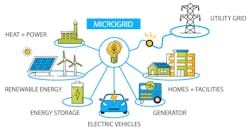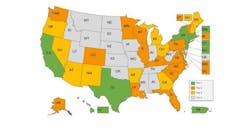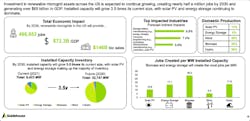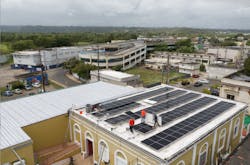Are you a policymaker, community leader or advocate trying to learn more about microgrids? Microgrid Knowledge has prepared this resource page to help you find answers.
Begin by viewing this short and engaging video, Microgrids Now!, prepared by the Civil Society Institute, Think Microgrid, RMI and the Millennial Action Project. It explains the basics of microgrids and why they are a game changer for the US energy grid.
Credit: 3 More Frames
The video also talks about research from 2019/2020 that found microgrids enjoy bipartisan support. A follow-up study of 1,100 adults, conducted in October 2021 by a bipartisan team of pollsters — Lake Research Partners and Breglio and Associates — found that after learning more about microgrids, 79% of adults favor increasing the use of microgrids.
If this video is helpful, please feel free to send the link to others who might benefit from the information.
To learn more about why and how the video was created — and the organizations behind it — read this article.
Shorter versions of the video also are available for universal distribution.
Microgrids as a climate solution
To take a deeper dive into the policy implications of microgrid technology for communities and governments, particularly those pursuing sustainability goals, see the white paper, Microgrids: A Immediate Climate Solution by Think Microgrid, an educational organization that provides a coordinated approach to building relationships and leading discussions with policymakers, regulators and lawmakers who are interested in microgrids.
Designed to help leaders better understand the value of microgrids and the government actions required to help communities more readily adopt them, the paper focuses on:
- How the grid is not prepared for the 21st century.
- Why microgrids are a 21st-century solution.
- How to capture the full benefits of microgrids in climate change strategies and infrastructure plans.
“The decisions of policymakers today establish and design the markets of tomorrow. Technology catches up with — and often outpaces — policy, which means that policymakers today bear a great responsibility. They are charged with designing utility markets that are resilient, clean and equitable. This is a daunting task, but they do not have to act in isolation,” said Cameron Brooks, executive director of Think Microgrid, in the preface to the paper.
What is your state doing to advance microgrids?
You may wonder what kind of microgrid policies your state has — and how those efforts stack up against what other states are doing. Here again Think Microgrid has some valuable insight with its State Policy Assessment Evaluation Framework and Analysis.
Think Microgrid studied state actions taken to advance microgrid markets and policy. The organization scored each state based on five criteria, each representing an area for microgrid market and policy growth. They are deployment, policy activity, resilience, grid services and equity.
The state policy assessment marks the first time any organization “has looked specifically at the policy landscape for microgrids where it matters the most — at the state level,” said Brooks.
California, Hawaii, New Jersey, New York, Connecticut, Massachusetts and Texas score as the top states for microgrid policy activity, with Puerto Rico also listed in the top tier. Together, these top jurisdictions represent more than one-third of the electricity market in the US and have significant microgrid activity, Brooks said.
Tier 1 states demonstrate higher overall deployment, more proactive policy, more active utilities, and resilience and equity priorities playing a significant role in state planning. Tier 2 states are emerging policy markets with certain limited programs or policies, but little comprehensive activity. Tier 3 states are nascent markets with policies or programs that have the potential to lead to microgrid policy progress or development in microgrid-adjacent topics including distributed energy resources, energy storage, grid modernization, decarbonization, or resilience planning. Tier 4 states did not indicate significant signs of activity related to the evaluation criteria. Credit: Think Microgrid
What about microgrid jobs?
It’s well known that microgrids can provide energy reliability, sustainability and often cost savings. But are there other benefits?
Guidehouse describes economic benefits associated with microgrids in the form of job creation in a research report, The Renewable Energy Economic Benefits of Microgrids. Guidehouse prepared the report for the Civil Society Institute, the Millennial Action Project and Rocky Mountain Institute.
Every million dollars invested in renewable energy microgrid assets creates 3.4 skilled jobs and $500,000 in additional economic benefits, according to the report. Nearly 500,000 new jobs will be created just from the components of microgrids over the next decade.
“There are a lot of economic benefits generated by microgrids in all states but, in particular, California and Puerto Rico,” said Peter Asmus, the report’s author.
The report found that in California microgrids yielded 4,670 jobs and contributed $0.85 billion in GDP and $1.76 billion in business sales as of 2021. Over the next 10 years, California’s renewable asset microgrid capacity is expected to grow 14.5 times. That will yield 10,500 MW by 2030. As a result, spending on renewable microgrid assets is expected to produce 166,600 jobs and contribute $22.2 billion in GDP and $45.5 billion in business sales.
In Puerto Rico, renewable microgrid assets are expected to yield 9,030 jobs by 2030. Of those, 5,030 will come from storage investments, and 2,880 will be derived from solar, said the report. Puerto Rico needs microgrids to keep the lights on, and if solar PV and energy storage can be integrated into microgrids, much-needed resilience will be a benefit, according to the report.
Puerto Rico as a microgrid model
Puerto Rico accelerated its microgrid journey after its central electric grid was destroyed by Hurricane Maria in 2017.
RMI has been a key partner in helping Puerto Rico recover through its Island Energy Program, which has helped island governments, utilities, regulators and civil society in more than 18 Caribbean nations to solve their energy challenges. The program works with island partners to develop clean energy pathways tailored to meet national goals and needs, foster energy independence and realize a climate-resilient future for all.
A critical facility in Arecibo, Puerto Rico, a part of the Community Energy Resilience Initiative piloting phase, is projected to save 20% on electrical bills from their microgrid system. Credit: RM
More information
For a deeper dive into many of the reports and programs described here, we encourage you to watch the Think Microgrid panel discussion with the people who made them happen.
To learn more about microgrids, please view the Microgrid Knowledge About Microgrids Page, where you will find such articles as:
- What is a microgrid?
- Microgrid benefits: Eight ways a microgrid will improve your operation … and the world
- History of microgrids in the US: From Pearl Street to plug-and-play
- Choosing the type of microgrid that is right for your operation
- Think you’re ready for a microgrid? Answer these questions first
Check this resources page for periodic updates on the work to advance microgrids being undertaken by the Civil Society Institute, the Millennial Action Project, RMI and Think Microgrid.
Please forward the link to the Microgrid Resource Page for Policymakers to others who you think may be interested in learning more about microgrids.
About the Author
Elisa Wood
Editor-in-Chief
Elisa Wood is the editor and founder of EnergyChangemakers.com. She is co-founder and former editor of Microgrid Knowledge.



